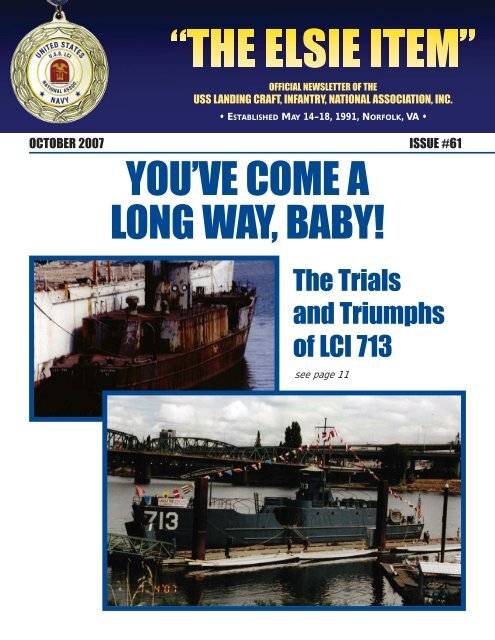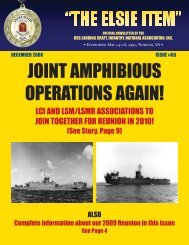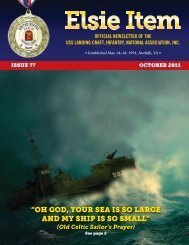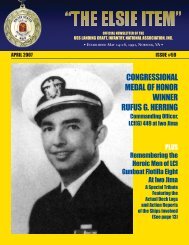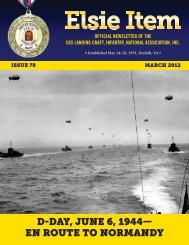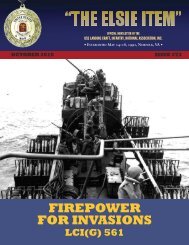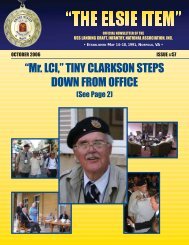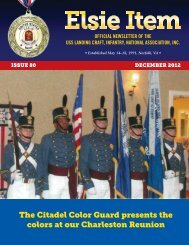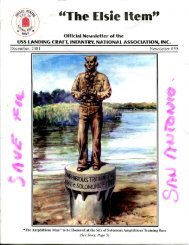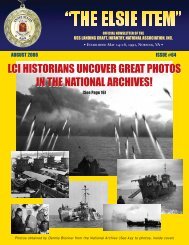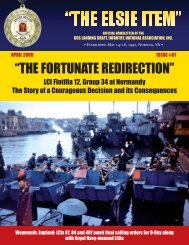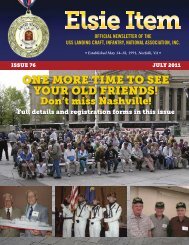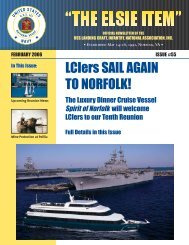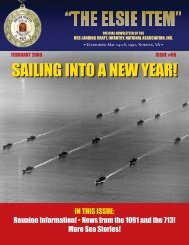elsie item issue 61 - USS Landing Craft Infantry National Association
elsie item issue 61 - USS Landing Craft Infantry National Association
elsie item issue 61 - USS Landing Craft Infantry National Association
- No tags were found...
Create successful ePaper yourself
Turn your PDF publications into a flip-book with our unique Google optimized e-Paper software.
A Word from the EditorEditing your newsletter is mostly a great joy – though sometime it’s closeto being a pain in the you-know-where when things don’t fit, or get lost, orthe right words just don’t come for something you want to say. But thepayoff in expressions of gratitude is so great that I am constantly thankfulthat I have the challenge of putting this magazine together. I supposethere are other things I could do to occupy my “retirement” years, but fewwould give me as much satisfaction.Our cover story and feature piece is, once again, our old friend the 713. Iknow you’ve read about her many times in past <strong>issue</strong>s, but recent developmentsand prospects for the future are so interesting that I decided tomake it our showplace piece again. The old lady has had quite a life – and the best is yet to come for her.As we feature the 713, we certainly don’t want to forget the vessel that has been designated as the flagshipof our <strong>Association</strong> – the 1091. We intend to feature her in the next <strong>issue</strong> as we do the 713 in thisone. In many respects, she is much farther along in the restoration-renovation process than is the 713,for she did not suffer the years of neglect and abuse that the 713 did. She actually has engines! Grantedthey are not the originals, but they do move her! Should the many obstacles be overcome and she is ableto join us in Portland for our 2009 reunion that would be one of the greatest thrills we could imagine.We’re happy to share news of several developments in this <strong>issue</strong>. Perhaps most exciting is the report onthe research efforts to be made by Affiliates Dennis Blocker, Roger Grey and John France to retrieve andmake available to us, the photographic riches of the <strong>National</strong> Archives. The dedication of the AmphibiousMan memorial at Solomons, Maryland, was a memorable occasion. I was glad to be there to representyou, and I share some of that with you here also.We’ve got some interesting sea stories from our WWII days to share with you here, too; and we do hopeyou enjoy them. Also, please read what’s coming at our 2008 reunion in beautiful Mobile, Alabama, andbegin making your plans now.Have a good read, Shipmates!—John Cummer3
WELCOME ABOARD!And still we continue to find LCIers who are just learning that there is an association of men who servedas they did on those little ships!A very hearty, WELCOME ABOARD to each and every one of you!New First Time MembersLCI 93Robert B. McCroryPrairiesville, LALCI(L) 768George B. PearsonMiami, FLLCI 773Robert H. <strong>Craft</strong>, Jr.Media, PALCI(M) 801Coleman GoodwinBaytown, TXLCI(L) 1020William E. Williams, JrFalls Church, VALCI 1079Arthur W. ChristyW. Bloomfield, MILCI?William J. GoodingScottsdale, AZNew Life MembersLCI(L) 334Charles j. ChattertonSummerfield, FLLCI(L) 479Jerome SteinmetxPenn Yan, NY (Summer)Wellington, FL ( Winter)LCI(L) 541Walter BergRiverside, NJLCI(L) 652Charles R. MastersonSpringfield, ILLCI(G) 726Forrest D. CoontzFlushing, MILCI(M) 805John D. ChambersFort Worth, TXNew Lifetime AssociateMembersLCI 26Mary K. LandryFridley, MNLCI?James DudrowVenice, FLNOTICE:In order to enhance the association’s financial stability in the years to come, the Board of Directors hasdecided that it would be wise to refrain from issuing any more Life Memberships.All applications for life membership received prior to the publication of this <strong>issue</strong> of the newsletter willbe honored.6
LETTERS TO THE EDITORWe’ve got an interesting mail bag to share with you for this <strong>issue</strong>, so let’s have at it!Gresham, OR:Ivan Gilliam, LCI(FF)Wow! A pleasant surprise. My ship, LCI(FF),Flotilla 3 Flagship was pictured on page 18 ofthe most recent Elsie Item, and referred to severaltimes in some of the deck logs. Then on page 23my name appears first on the list of men whoserved aboard the ships listed. Quite a surprise!Carson City, NV:William Burke, LCI 1030Keep up the good work! I appreciate yourefforts and the excellent newsletter.I would like to hear from former shipmates, butdo not see any listed. I do not have a computerso am a little limited in checking on my formershipmates who might have email addresses.Birkenhead, England:S/M Bob Bell, LST and <strong>Landing</strong> <strong>Craft</strong> <strong>Association</strong>The news of the passing of Tiny Clarkson reached ourshipmates in England and prompted this responseJust a few lines to say how sorry our U.K.<strong>Association</strong>s were to receive the sad news ofHoward’s passing, and the wonderful tributesthat have been paid in respect of his service asTreasurer, and one of the founder members ofyour <strong>National</strong> <strong>Association</strong>.His graveside service with full military honors atthe Saratoga <strong>National</strong> Cemetary was a fittingtribute to a gentle giant who will be rememberedby all who had dealings with him on joiningyour association.Yours in comradeship.Lexington, MA:Albert D. Ullman, LCI(L) 500Elsie Item has lots of stories about heroic behavior,and I want to add one more that is a little different.I was C.O. of LCI(L) 500. The main thing we didwas take British troops into Gold Beach on D-Day. Nothing heroic, even though our crew ofmainly 18-19 year olds behaved magnificentlyas always. But the heroism I want to writeabout occurred every day we were underway.Chicago, IL:Ross Fragale, LCI(R) 1077Just a short note to say how much I enjoyedseeing a picture of Jack Dempsey. [Issue 58, page15, “Saluting our Coast Guard Shipmates] That picturehas to be a classic.He was my idol back in the 30s. Any kid whoput on a pair of gloves wanted to be JackDempsey.PS Keep Elsie alive!F1C Donald Schmitz had chronic seasickness. Ioffered to have him transferred, but he askedme not to. Every watch, he took his bucket andwent down to the engine room. I’m sure youremember how hot and smelly it was. For theyear we were togethere on the 500, Schmitznever missed a watch! My hat was off to himthen, and it still is.7
Largen, a pilot who crashed and my husbandwas sent to find his remains. . . .My husband is now 84 years old – takes no prescriptionmedication and does not look his age.He is a trim 160 pounds, but his memory isshortened with the years.He captained his ship on its return to the statesat war’s end. He became a lawyer, then a commonpleas judge for 27 years. He is a compassionategiving man. We have six children andeleven grandkids.Even as his memory fails him, still there aretimes of that period, triggered by what I do notknow, which reduces him to tears for just a fewmoments and then he is alright again. I am sureyou have heard such many times.I tried to encourage him to attend LCI reunionsand especially here in Ohio, but he would beembarrassed and he is now too old to travel.The confusion would be too great.He wanted you to have the log of his ship foryour archives.Here is one that gives me joy to share. This expressionof gratitude from one of our Associate Members is thesort of thing that makes the work of publishing ElsieItem a most satisfying occupationMurfreesboro, TN:Lydia Newman,Daughter of James Newman, LCI 663. . . .My dad had every single <strong>issue</strong> that you published.I only became aware of “Elsie Item” in thelast three or four years. Dad was blind for thelast 28 years of his live. We were so excitedwhen each <strong>issue</strong> arrived. He would keep it outso, on my next visit, I could read it to him, coverto cover. He especially loved the articles aboutlife at sea on an LCI. When I, landlubber that Iam, would stumble over some nautical term, hewould patiently explain what it meant and howit applied to the situation at hand.. . . .I truly cannot tell you how his associationwith the Navy and the LCI filled him with pride.In his den he has an exact to scale replica of “hisship” and his license tags proudly proclaim “LCI663” to the world.All of my life is filled with memories of storiesDad would tell us of the Navy. And in the lastfew years, cries of “tell us a story, Papa” from histhree grandsons would be all that he needed tolaunch into the telling of a tale – new to thoseboys but a fond retelling for the rest of us.Most of Dad’s stories of his adventures werefunny, usually with himself as the butt of thejoke, filling the room with laughter. A few ofthen were sad, bringing tears to our eyes as weheard of the pathos of wartime. He never toldthe traditional “blood and guts” war stories. Histales usually held lessons in them. He wasalways the teacher, trying to give us life lessonsat every opportunity.. . . .Dad died on August 19th of this year. I cannotbelieve that he is no longer here. At hisfuneral we had military honors, with the flagdrapedcoffin and the playing of taps. Therespect and honor thy gve to Dad were trueexamples of the Navy that he so loved.Thank you for the joy and sense of pride yougave my Dad with every <strong>issue</strong>. You will neverknow all the memories I made with him as Iread your magazine to him. Our discussionsover your articles inevitably led to those wonderfulstories of his life aboard his very own ElsieItem.When I would read each <strong>issue</strong> to Dad, I could nothelp but notice the children and grandchildrenof veterans who have become affiliates. I, too,want to be a part of this very special family.Please accept me as an affiliate through LTJames O. Newman, my Dad.9
YOU’VE COME A LONG WAY, BABY!The Trials and Triumphs of LCI 713What a tale!From her proud beginning as a participantin Pacific combat landings in World War II, toher demise as a rust-bucket sitting on the bottomof the river after years of neglect andabuse, to her incredible resurrection due tothe almost fanatic dedication of men like WaltJames, Leon Gilbo and a crew of hard-workingvolunteers, the ship has an inspiring story.It’s a story many of us have had the privilegeof sharing in or observing. Now, sinceshe figures largely in our plans for our 2009reunion – and because she is a living reminderto all of us of our own LCIs - we want to bringyou up to date with a resume of her past historyand some of her latest adventures – andmisadventures!Showing unmistakable signs of years of neglect, the 713awaits the attention of her dedicated restorers11
The <strong>USS</strong> LCI <strong>National</strong> <strong>Association</strong> Meets the 713Sporting a beautiful coat of wartime grey paint and her campaign ribbons, the 713 awaits the LCIers reunion visitAs the work progressed, interest and enthusiasm grew. The LCI <strong>National</strong> <strong>Association</strong>, seeing the progress,decided to hold their 2004 reunion in Portland at the Red Lion Hotel where the 713 would be mooredalongside. The prospect of treading the steel decks of an LCI again attracted a record number of LCI<strong>Association</strong> members to that reunion.Interior spaces, the officer’s cabin and the wheel house, come to life13
As the restoration took a more and more visibleshape, an organization was formed to give leadershipand coordinated effort to the project.Chaired by LCI <strong>Association</strong> member GordonSmith, the Amphibious Forces Memorial Museumbecame a legal entity.Pier 39 AstoriaFor a long time, the LCI found a somewhatmakeshifthome moored to log booms up theWillamette River. The possibility of a much morevisible and attractive home came when FloydHolcom, the owner of a former cannery on Pier 39in Astoria, saw the possibility of the 713 being anattractive addition to his plans for converting thecannery into the home for a range of businesses, arestaurant and a bed and breakfast. His offer offree mooring at Pier 39 was enthusiasticallyaccepted by the board of the Amphibious ForcesMemorial Museum and the 713, sans engines,made the journey down the Columbia River propelledby a small tug boat lashed to her stern.Pier 39 was home for the 713 for two yearswhen it became apparent that the location,more exposed to salt water and harsher weatherdue to the immediate proximity of the stormyPacific Ocean, was causing further deteriorationof the hull. It became apparent that the vesselwould need to be returned farther up river.The 713’s return up-river in August of 2006was something of a triumphal procession. JerryGilmartin described it in a News Update for theMuseum’s website:“The 713 was powered by the “Ramona II”,Clark Caffal’s reliable river tugboat, pushing theveteran <strong>Landing</strong> <strong>Craft</strong> on the all-day trip toPortland. While underway, the LCI flew a full setof signal flags and one of the largest US flagspossible to fly from a ship of her size. Walt Jameseven hooked up the ship’s horn and signaled thetown of St. Helens as we passed by. During thetrip, hundreds of startled people on the riverwaved and shouted and took pictures of thisproud warhorse as she passed. More than oneperson asked “What kind of a ship is that?” andwere answered proudly,“She is one of the onlyremaining WWII <strong>Landing</strong> <strong>Craft</strong> still afloat, and iscalled an LCI”.Return to the Red LionDue to the generosity of Howard Dietrich,owner of the Red Lion Hotel, mooring facilitieswere provided for the 713 in the same placewhere she was viewed by LCIers at their 2004reunion. The list of restoration projects completedis impressive. It includes such <strong>item</strong>s as thecomplete restoration of all wiring, installation ofbunks in the troop compartment, conn and pilothouse refurbishing and replacing of many of thedeck plates. All this work continued as ChiefGilbo led parties in scouring the U..S. .NavalReserve Fleet in Suisan Bay, California for whateverparts and materials might be used.An Unexpected VoyageSometime during the night of Monday, March28, 2007, vandals cut the mooring lines of the713 and an antique Coast Guard Cutter, the Alert,which was tied alongside. It was a dangeroustime for both vessels as they drifted downriverand the winds rose to 20 knots. Fortunately, thetwo vessels came to rest against dolphins alongthe shore line. The 713 was returned to hermoorings by a tug boat of the Tidewater BargeLines who generously contributed their servicesto the rescue.The Alert did not fare so well. Suffering holesin her bottom, she was sinking when Walt Jamescame to the rescue. At the risk of his life, Waltmade a dive under the vessel to place heavy waxin the largest holes. This stopped the inflow ofwater and kept the cutter from sinking. For this,he earned the admiration and respect of allthose concerned with the preservation of the oldcutter. Of his action, Gordon Smith commented:“Would I like to make a dive under a ship thatwas sinking and not really knowing what I wouldfind under there? Hey, Walt, WOW!”The Portland Rose Festival—Almost!Just prior to this unexpected adventure,Gordon Smith and his associates, who hadaccepted ownership of the 713 from Walt James,were delighted to receive an invitation for the713 to participate in the Portland Rose Festival inJune of 2007. The possibility of such favorableexposure to a large audience was exciting andthey began making serious preparations to put14
the ship in her best possible shape.But the U. S. Coast Guard had other ideas.Concerned that to move the vessel down rivermight result in her sinking, Coast Guard Captainof the Port for Portland, Patrick Garrity, orderedthat the 713 was not to be moved unless it was toa shipyard “for dry docking and associated repairs.”It was a severe blow to the crew of dedicatedrestorers, but under the leadership of GordonSmith, they re-grouped and planned an appeal.Action was not possible in time for the 713 toparticipate in the Portland Rose Festival, but thencame a second invitation to participate in anotherPortland event, the First Annual MaritimeHeritage Festival. August 3-4, 2007.An Expert Naval Architect Comes to theRescueMr. Thomas S. Winslow, Naval Architect andMarine Consultant, has a most impressive list ofcredentials and extensive experience on a host ofmajor marine design and construction projects.Through the efforts of members of theAmphibious Forces Marine Museum, he becameinterested in the plight of the 713 and generouslyvolunteered his services to inspect the vessel andmake a recommendation to the Coast Guard.After a thorough inspection Mr. Winslow determinedthat the vessel was of no danger to riverwaters if towed to the Festival.With this expert opinion in hand, GordonSmith crafted a respectful request to the CoastGuard for re-consideration of their ban on anymovement of the 713 except to a dry dock forrepair. He urged reconsideration on the groundsthat the public exposure during the festival wouldbe of significant help in fund-raising for completerestoration.The letter and supporting expert opinion didthe trick! With only hours to go before the openingof the Maritime Festival, Captain Garrityrelented and granted approval for the move.Optimistically anticipating a favorable response,Smith and his crew of restorers had Captain ClarkCaffal and his tug boat Ramona III standing by.As soon as the approval was received, it was “fullsteam ahead” and the 713 made her triumphantvoyage to the Festival.With bunting flying, the 713 arrives for the MaritimeHeritage FestivalIcing on the cake came when the Navy Captain of thePort , Commander Jami Mason, joined Gordon Smith onthe bridge of the 713. There is no mistaking Gordon’sdelighted grin in the picture taken at that time!.On to 2009Though there undoubtedly will be more trialsin the future, the optimism of Walt James, LeonGilbo, Gordon Smith and the whole dedicatedcrew is undiminished. So much has been accomplishedthat seemed impossible that even thedaunting prospect of having to raise thousandsof dollars for a complete restoration of an intacthull and even more for engines is not enough todeter these hard-working, determined men andwomen. Though by no means the final chapter inthe saga of the 713, the meeting of the LCI<strong>National</strong> <strong>Association</strong> in Portland in 2009 will becertainly be a landmark event.15
JIM McCARTHY ON THE BINNACLE LIST;JOE FLYNN TAKES THE HELM AS ACTING CALIFORNIA DIRECTORSuffering a bit of physical set-back with surgery and rehabilitation,State Director Jim McCarthy has asked Affiliate Joe Flynnto take over for him until he’d back up to full speed. With theCalifornia State Reunion planned for September 25-28 inEureka, Joe has his work cut out for him and, (with lots ofadvice and direction from Jim) is getting things well planned.Joe reports that Jim is doing fine and is in good spirits. And, asyou might expect, he has taken advantage of his hospitalizationto spread the LCI story.“By now”, says Joe Flynn, “I think all of the staff where Jim isstaying could pass an exam on LCIs! Jim always has a calendarwithin reach so he can show them pictures of LCIs inaction and point to the dates for invasions during World War II.”Jim celebrates his 82nd birthday in rehabwith his “main squeeze” Shirley Paleyand Joe Flynn’s wife GloriaWe all join Jim’s California shipmates in wishing him a speedy recoverySECRETARY BOB McLAIN SUBMITS RESIGNATIONHe’s been there since the beginning of the LCI <strong>National</strong><strong>Association</strong>.Bob McLain, who served as MoMM1C aboard LCI 436, has had tosubmit his resignation due to health considerations.Bob writes, “After having a heart valve replaced, I discovered that Ihave a compressed fracture of the spine. I will no longer be able toattend our yearly meetings and will miss them very much. Theywere a joy to attend.”His resignation was accepted with regret and with expressions ofthanks for his long and faithful service to the <strong>Association</strong>. One ofthe original founders, he has always been known for his understandingof the procedures and by-laws and his counsel hasalways been as effective as it was appreciated.We all wish Bob well and hope that his health may improve so that we may see him again at some futurereunion.Treasurer Hal Bleyhl has agreed to assume the duties of Secretary pending the search of a replacement.It is hoped that we will find one among our Affiliate members.16
AFFILATES BLOCKER, FRANCE AND GREY TO RESEARCHLCI PHOTOS IN NATIONAL ARCHIVES.France, Grey and Blocker prepare for an intensive research projectThe Officers and Board of Directors have acted favorably on a proposal from Dennis Blocker, newly-Appointed LCI Historian for the Pacific Area of Operations, for a team of researchers to make an exhaustivesearch of the <strong>National</strong> Archives in Washington, D.C., in order to locate and retrieve all photo coverageavailable on <strong>Landing</strong> <strong>Craft</strong> <strong>Infantry</strong> and to index those photos so that LCIers can order prints of their ownor any other LCI.The project represents one of the first significant steps taken by the newly-organized Affiliates toaccomplish their objective of preserving LCI history.Based on previous trips to the <strong>National</strong> Archives to obtain coverage on his grandfather’s LCI – the 449 –Dennis developed a proposal for a team of three researchers to be sent to the <strong>National</strong> Archives to scanand obtain for the LCI <strong>Association</strong> and other WWII researchers the untold number of LCI pictures availablein those archives. Blocker will be joined by Affiliate Member John France, LCI Historian for theAtlantic War, and Roger Grey, Affiliates Organizing Chairman.Armed with flat bed scanners, the research trio will descend upon the Archives during the latter part ofSeptember, 2007, when the Archives will have extended hours.The plan is for the pictures to be indexed and sorted according to LCI number and by operations. Initialavailability of the photos will probably be at the 2008 reunion in Mobile where they will be put on display,and LCIers can order the pictures they want. From the discs on which the pictures have beenscanned, individual CDs will be made up and given immediately to each person ordering photos. If theperson ordering the disc does not have computer capability for printing photos from a disc, the disc canbe taken to a place offering photo service (such as Wal-Mart or CVS Pharmacy) where prints of the photoscould be made. Other methods of making the photos available to LCIers not able to attend reunions willbe explored.17
“ON WATCH” MEMORIAL DEDICATEDAT SOLOMONS, MARYLAND“On Watch”It was a bright, clear late-summer day beside thesparkling waters of the Pautuxet River as a largecrowd gathered to dedicate an eight-foot bronzestatue honoring Amphibious Force sailors.The monument commemorates the AmphibiousTraining Base that was located in Solomons,Maryland, and the men and women who servedtheir country in World War II. This, the nation’sfirst amphibious training facility, was active forfour years, from 1942 to 1945. The base,designed to accommodate about 2,000 men andto prepare them for the planned invasion ofNorth Africa, quickly filled the entire 109 acresite. At its peak in the summer of 1944, the basehad 10,150 men aboard and sent them to all ofthe U. S. Fleets in the Pacific and Atlantic Oceans.Maryland artist and sculptor Antonio TobiasMendez created the ”On Watch:” statue. It is surroundedby a Veteran’s Plaza, with bricks bearingthe names of WWII veterans who purchased thebricks as part of the campaign for funds for thememorial. A total of 313 bricks were purchased,raising $31,300 to help pay for the statue.18
“I had the choice of fighting either Linda Kelly orthe whole Maryland Senate. I figured it wouldbe easier to fight the Senate!”Commissioner Kelly picked up the challenge toraise the matching funds that this bond billrequired. She sold bricks at American Legion halls,community functions, through Comcast interviewsand newspaper articles, as well as solicitingdonations from businesses and organizations.The plaque recognizing the contribution of the<strong>USS</strong> LCI <strong>National</strong> <strong>Association</strong>The LCI <strong>National</strong> <strong>Association</strong> was one of the earliestsupporters of the project. LCI officers Jim Talbert,Tiny Clarkson and John Cummer were present whenthe project was first announced at the 2001 “Cradleof Invasion” celebration. As a donation of $500 wasannounced,Tiny turned to Jim and said,“Want totrump that? Why don’t we donate $1,000?”Seconded by Cummer, Talbert went to the podium,introduced himself and announced thedonation of $1,000 from the LCI <strong>Association</strong>!Subsequent donations totaled $3,000 and wererecognized by a special plaque on the wall surroundingthe Veteran’s Plaza..The ceremony was the culmination of an extensiveand enthusiastic campaign begun by KarenStone, then Curator of Education for the CalvertMarine Museum. Leadership was assumedenthusiastically by Calvert County CommissionerLinda Kelly. Her efforts encouraged local, countyand state officials to provide significant financialsupport for the project. It was at her urging thatState Senator Roy Dyson and Delegate AnthonyO’Donnell sponsored a $50,000 bond bill fromthe State of Maryland to fund the project. In hisremarks at the dedication ceremony, SenatorDyson said:Recognition was also given at the ceremony ofthe generous support given by the CalvertMarine Museum Society and to Matt Gambrill,owner of the Calvert Marina, who gave permissionfor the memorial to be built on this valuablesite.The impressive statue serves both as a reminderof those amphibious sailors in the past whofaithfully stood their watch and of the necessityof present and coming generations to stand theirwatches diligently.The ceremonies were presided over by RearAdmiral Timothy Heely, a veteran Navy fighterpilot whose present assignment in the Naval AirSystems Command gives him responsibility forthe development and testing of strike weaponsand unmanned aviation systemsLCI <strong>National</strong> <strong>Association</strong> President John Cummerwas privileged to participate in the ceremonies.He was asked to reflect on “Why We MustJohn Cummer, Calvert County Commissioner LindaKelly and high school orator Jake Land19
Remember. His remarks were followed by thosefrom Jake Land, a young high school student,who spoke concerning the inspiration and exampleof his grandfather who served aboard an LCIduring WWII.After reminiscing a bit about some of the experiencesWWII Amphibious Force Sailors shared duringtheir Solomon’s Island training days, Cummer,thinking especially of our Associate Members andof the important role they will play in preservingour heritage, made the following remarks:“We remember because we were here. Because itwas our lives. Because our shipmates were OURshipmates. Bonds were formed that will never bebroken. We have cause to remember.“But what of those who come after us? Whatwill they know of the times and events which weexperienced first hand? Why should theyremember anyway?“In a way the answer is old and time-worn, but itis still a valid one—we must remember—theymust remember—because those who forget theirhistory are required to repeat it.“In our youth, an evil force—driven by fascismand radical nationalism arose and herculeaneffort was necessary to defeat it and insure thecontinuance of our life in the land of liberty.“Subsequently, in Korea, and in Viet Nam, youngmen made great sacrifices. For years it was necessaryto wage a “cold war” against communism.“Today in Iraq, Afghanistan and other places otherforces of totalitarianism and radical but misplacedzeal have arisen to require yet another generationto stand against them. Young people, now bothmen and women, are called upon to sacrifice theiryouth for the safety and well-being of family andcountry. Past generations have stood fast; thepresent generation is standing fast.“So, it is good and right to erect a monument tothose who stood firm in one generation toremind succeeding generations that, as it is socommon to say today, freedom is not free.“In the Old Testament, the story is told of howthe Israelites were about to enter the promisedland, after long and hard struggle. God directeda special sort of event at that time which wellcould serve to describe what we do here today.As the Israelites passed through the Jordan River,one man from each of the twelve tribes wascommanded to pick up a large stone from theriver bed and, upon reaching the other bank, pilethose stones into a monument.“And why?“Because, we are told, when children yet unbornwould look at that heap of stones and ask “WhatMean These Stones?”, they would be told thatthey were to remind them of their God-givendeliverance in days past, of the heroes whofought the battles and of the need for them togive themselves to the same struggle for justiceand freedom under God.“Someday, some child will look at this magnificentstatue and will ask, “What does it mean?”God willing, someone will be there to reply, “It isthere to remind us of men who sacrificed muchfor your freedom—and to remind you and methat we must also be ready to defend or Godgivenfreedom”“That is why we must remember.“Each succeeding generation must rememberthat they, too are“ON WATCH”20
MECHANICAL ENGINEER DEVELOPS DETAILED LCI MODELS.Raigo’s computer generated drawing of LCI(L) 224Alexander Raigo, a mechanical engineer, is developingelectronic models for LCIs which, in detail,far surpass any yet produced, either by professionalor amateurs.Raigo, currently a resident of Hellerstonwn,Pennsylvania, has over 34 years of experience inmechanical engineering and has given muchtime and effort to the eventual production of LCIModels as the illustrations with this article canattest.Raigo contacted President John Cummer withthe request for information as to how to contactthe men who were restoring the 713 so that hecould obtain some detail about the ramp on thebow door model. As the conversation developed,it became apparent that Raigo’s work should beshared with LCIer.Raigo comments on his drawings as follows:“The first picture shows a general assembledview of the LCI(L)-224, a typical middle to lateproduction LCI(L)-1 to 350 class ship.“The detail differences even within this class ofsquare cons are, of course, many. In this picture,the main hull and main deckhouse assembliesare seen together, with a number of <strong>item</strong>s notfitted. These include gangways (side ramps);Oerlikons; compass, pelori, voice tubes, signalsearchlight and seats in conn station; rail stanchionsand rails and the stern anchor windlass.Due to computer limitations, I cannot yet assemblethe complete hull and superstructure,although I can assemble them complete separately.All these <strong>item</strong>s are already modeled.”As a further example of the detail of Raigo’swork, the second picture is of the Bayard sternanchor windlass type I.Raigo notes, “The model is fully functional andincludes all the gearing, but little informationcan be found on the Wakesha XAHU engine thatpropelled it. The types III and IV used in the 713only differ in the gearing and controls”.Work is still progressing on the 350 round conn,side ramps class. Raigo notes that he is stillmissing details for such things as the fathometer21
and fog generator at the stern of the ships. He iscontinuing research to tie these details down.“All 302 ships in the class can be characterizedwith just six variants (they did not have enoughtime to introduce a large amount of changes). Tomy knowledge, all the ships built with the Britishstyle lower navigation bridge were sent directlyto the Royal Navy and Royal Canadian Navy.“I am about 40% complete on the 351-1098 class,but some vital <strong>item</strong>s are still missing from mydocumentation; I can complete about 95% of theships with what I have. Variants abound forthese. Out of 351-402 there are at least 27, andthe rest of them had a whole lot of other changesas well. Some of the differences are small, othersare major. Curiously, the basic shape of the hullremained essentially the same for the whole production,and even for the LCS(L)(3).”“These methods”, he says, “will allow me theleast expensive way to produce the small numbersof accurate model kits I expect to sell to thegeneral public (very far from profit, actually) sothat I can defray the cost of all the replicas Iwant to make at no cost for a number of associationslike your own, museums and other institutionsof learning.”Raigo feels that LCI(L)s have never really beenwell represented in model form and he wants tocorrect that. We all can be most grateful for thisexcellent and detailed work which will do muchto the preservation of the heritage of LCIs.Should you wish to contact him, his address isAlexander Raigo, 1866 Leithsville Road, # 117,Hellertown, PA 18055 His telephone number is(201)560-6632 and his email address is threedeewiz@yahoo.com.Raigo has specialized in electro-mechanical productdevelopment. For a number of years he hasbeen working on contract, moving about frequently.In the last year he has lived in four differentstates.“This year I have been in two so far, andnumber thee may be coming up verysoon,” says Raigo. “and I carry aroundmy two computers and two cats withme wherever I go. It is a strange life”.Raigo plans in time to produce a series ofscale replicas, based on his engineeringmodels. He notes that a considerableadvantage of these electronic models isthat they can be scaled down to anyscale. After adjusting the sizes of thesmaller features to suit the scale, he canthen make prototype parts directly fromhis 3-D files, and they can in turn be usedto make molds for casting additional setsof parts, which then can be used as a kit,together with instruction sheets, decalsand photoetched brass parts (alsoderived from his engineering models).The Windlass22
FACES FROM THE PAST:WHO ARE THESE MEN FROM LCI 339?ByJohn VickermanNephew of ENS Harlan Moen, LCI 339Millersville, MarylandJohn Vickerman, whose uncle served as an officeron LCI 339, came across the negatives of thesephotos of some of the officers and crew of LCI(L)339 and needs help in identifying some of thecrewmen pictured. The 339 was lost throughenemy action, 4 September 1943 during theEastern New Guinea operation at Lae. Can youhelp him in his quest to identify these crewmen?He writes:In the first photo, the officer on the left is my uncle,ENS Harlan Moen, the Executive Officer; the officerIn the center is thought to be LTJG James Tidball, theCommanding Officer; and the officer on the right isthought to be LTJG Fay Begor, M.D., the group medicalofficer.Dr. Begor was treating the wounded until thebombers “released their bombs at about 1,500feet, bracketing the ship with near misses to portand starboard, but scoring a direct hit just forwardof the pilot house, blasting a large hole in thedeck. The 339, nonetheless, gained the beach tocarry out her mission, though in a sinking condition.”Begor died of his wounds five days later andreceived the Navy Cross posthumously. Moen waswounded, but later returned to action. It isbelieved he later commanded an LCI(R).Harold “Mac” MacCombie of Framingham, MA,and LCI <strong>Association</strong> member, was on another shipthat day and wrote telling me that his ship hadtraded places with the 339. “When we were gettingready to land,” he said “we had an Aussie officerwho wanted to get in on the first wave. Wesent word for the 339 to change places with us,and we shot ahead. It was a good thing thatbeach had a steep slope, as we really plowed in.We pulled off, and then the Jap planes came in,hitting the 339 and the 441. I think the 441 wassalvaged, but the 339 was not.”According to the Dictionary of American NavalFighting Ships, the 339 had dropped anchor about150 yards from the beach and “came in for theunwelcome attention of three VAL bombers andthree ZERO fighters approaching on the starboardside. LTJG James Tidball, USNR, her CommandingOfficer, ordered fire opened, but the fighters beganstrafing almost continuously, riddling her withholes from stem to stern and causing considerabledamage amongst the troops.”None of the crew members in the second photoare identified. Perhaps someone in the associationknows some of them. I would appreciate hearingfrom anyone who served with my uncle, ENSMoen. I can be reached as follows:John Vickerman479 Old Orchard CircleMillersville, MD 21108jvickerman@earthlink.net”23
THE LAST ASSAULTOF LCI 373 (G)by Jimmie A. Prime, RDM 2nd Class<strong>USS</strong> LCI (G) 373Grand Terrace, CALCI (G) 373 steams past the <strong>USS</strong> Hopping on its way tothe Okinawa Invasion Firing LineOn the night of 25 March, 1945, we were en routeto Kerama Retto Nanse Shoto, Okinawa Shima, setto arrive at dawn for line of departure to assaulton Kuba Shima, an island of that group (March26). We made our fire mission using 40 and 20mm guns, at targets of opportunity. The actualtroop landing was canceled for the day.On 27 March we again went to the line departureand again used our 40 mm and 20 mm guns, plus4.5 inch rocket barrage. The troops were landed.This was to be the first of our many trips to thebeach in the nearly three month stay in theOkinawa Shima vicinity.We had made a number of troop assaults beforethese. That included the island of Saipan andthen Tinian, both in the Mariana Islands. We thenwere a part of Macarthur’s Navy for the assault atLeyte Island, and then Linguan Gulf at LuzonIsland in the Philippines.Between 24 March and 31 March, 1945, we wereto perform four fire support missions in supportof underwater demolition team swimmers(UDTs). I believe that we had eight LCIs lined upfor the UDT support. We had no way of knowingwhat to expect.This was the same support mission performed bytwelve ships from our flotilla at Iwo Jima, whichwere badly mauled by Japanese shore batteries inorder to do this. Eleven of them were hit andthey took many casualties.At Okinawa, it fell to our group to perform theseduties. In the picture are two old Battle Wagons(BBs) that were to support us if we encounteredheavy shore fire. We did not. We had just somesmall arms fire coming from burial vaults on thebeach.The Wagons were the New York (BB 34) and Idaho(BB 42). Also in the picture is the U.S.S. Hopping(APD 51) which served as Mothership for theswimmers and their small boats. The bow wavefor the LCI 373 shows that we were in a hurry toget to the firing line.On 1 April, 1945, we returned to our old functionof fire support for the assault wave, using 40 mmand 20 mm guns, and 4.5 inch assault rockets.This landing, at Okinawa Shima, served to securethe island before the possible assault of Japanproper. The battle for Okinawa Shima had begun,and we thought we would be leaving soon. Notso. Little did we know that our stay in this areawould be nearly three months.On 13 and 14 April, 1945, we again went to thebeach in support of UDT swimmers to clear thebeach for troop assault, at Ie Shima. This occurredon 16 April, 1945. We again used our 40 mm and20 mm fire, along with rockets, in support of theassault wave of troops. Some may recall that thiswas the same island where the very good friendof the “little guy” was killed while visiting thetroops. May the good Lord bless Ernie Pyle. Hewas shot by a sniper on Ie Shima.While at Okinawa, our time between beachassaults was used in almost continual patrollingfor small boat activity and dealing with Kamikazeactivity. This meant constant “General Quarters”.We were to finally leave Okinawa and the area inJune 1945, en route to Saipan. We were ready fora breather. This proved to be, unknown to us atthe time, the last assault by the LCI (G) 373.24
DID AN LCI ARRIVE AHEADOF SCHEDULE ON OMAHABEACH?The Puzzling Claim of a GermanHistorianA most interesting communication was recentlyreceived from Robert H. Wolf of New Orleans, LA,who has been translating several books aboutOmaha Beach by a German Historian Helmut vonKeusgen. Von Keusgen relates an incident reportedto him by a German soldier who was manning amachine gun on the beach defenses which, if true,would mean that an American LCI arrived atOmaha Beach at 0630 on the morning of June 6,1944, before the first waves of LCAs and LCVPsarrived.“It seems highly unlikely”, comments Wolf, “thatthis event happened at the time or quite in themanner described, but perhaps it bears someresemblance to an actual event”. Seeking to addsome clarification to the preface to the English editionof this German’s account, Wolf inquires if anymember of the LCI <strong>Association</strong> could shed any lighton the matter.The report is so interesting that we thought wewould share it with our readers and give you all achance to wonder at it along with us.The following is taken from “WN 62 –Erinnerungen an Omaha Beach, Normandie, 6 Juni1944” (WN 62 – Reminiscences of Omaha Beach,Normandy, June 6, 1944) by Hein Severloh, with theassistance of Helmut van Keusgen, a German historianand publisher, p55ff.At shortly before 0630, after the heavy bombardmentof their battleships had stopped, I noticed alarge, thin and tall boat in our bay coming fromthe northeast toward our wide ebb tide beach –directly in front of our sector and 600 metersfrom Strongpoint WN 62 (located just at theboundary between Easy Red and Fox Green sectors).It was a troop landing ship with a pointed bowand a shallow hull, next to which, on either sidetwo large gangplanks were lowered. An immensenumber of soldiers appeared at the railing whobegan to go down the gangplank loaded downwith weapons and equipment. One could see itclearly. Though we had, up until then, alwaysspoken of the “Tommies” we expected, I could seeimmediately from the shape of the helmets andthe large, white letters, US on the bow of thetransport that they were Americans. Theydescended the gangplanks calmly, in orderlycolumns and jumped into the cold, chest-toshoulder-highwater. Many went under for amoment and, half swimming, half wading; theybegan to move slowly toward the beach in frontof our strongpoint.At this time it was almost completely quiet inthe bay, and not a single shot was being fired.We had strict orders to wait until the GI’s wereonly about 400 meters from the upper beach, andin knee-deep water. I ran to the communicationsbunker about twenty meters distant, and calledback:“Now it’s starting; they’re landing!”The operators, who were busy constantly withthe telephone and the radio, couldn’t leave theirbunker, and for that reason they couldn’t knowwhat was going on outside. One of them said tome:“Hein, when you can, let us know what is goingon down there on the beach . . .”Then I ran back through the trench the few stepsto my machine gun. By that time more and moresoldiers had disembarked from the transport (anLCI(L) carried about 150 soldiers). After theAmericans got a footing, they waded in two longcolumns, one behind the other, through thewater, and each held on to the belt of the one infront with his left hand. Everything went in sucha cool and orderly way, as if they were merelyconducting an exercise. (The Americans had clearlythought, after the bombing and heavy naval barrage,that they could count on a complete absence25
of resistance from the German side.)First Lieutenant Frerking appeared next to me inthe trench, and we observed how the Americans,loaded down with weapons and equipment, toiledslowly forward, completely defenseless, throughthe high swells of cold salt water. It was clear tous that the G.I.s down there were about to enterinto their own slaughterhouse.“Poor swine. . .” Freking said softly to himself;then he went down into the bunker to give thecoordinates and firing order for the artillery. As Iturned back to my machine gun position I alsohad the feeling that I was ascending the scaffold.It had lasted about five minutes until theAmericans (units of the 1st U.S,. <strong>Infantry</strong> Division)reached the shallow water. I noticed the, for thefirst time that day, that there were soldiers ofthe Grenadier Regiment 726 at the strongpoint,for somewhat further down beneath mymachine gun position a sergeant and anotherinfantryman were trying frantically to get amachine gun (Model MG 324) into action – butit wasn’t working.I am not the type to look for trouble; I hadn’tthought of any such thing – whatever for?Behind me, the entrance to the strongpoint wasmined, and barricaded with a thick barrier ofbarbed wire. (That the heavy naval bombardmenthad totally torn up and disarranged everything upthere I only learned later.) Anyway, I was a soldier;a soldier who was going to be attacked, and assuch I now had to defend myself. I moved thesafety lock of my machine gun to the off positionand began to fire. I could see the water spoutswhere my machine gun bursts ere hitting, andwhen the little fountains got close to the GIs theythrew themselves down. After only a few secondspanic broke out among the Americans. Theyall lay in the shallow, cold water; many tried toget to the most forward beach obstacles to findsome cover behind them. Soon the first corpsesdrifted slowly in the waves of the slowly risingtide. I fired further among the many dark formsin the water, which were still about 300 metersfrom the upper beach. After a little while all theGIs on the beach had been brought down.Suddenly I had the impression that I was the onlymachine gun that had fired in our entire sector. Itis true that my machine gun made so much noisethat I could hardly have heard the others; neverthelessit seemed to me that I actually had firedcompletely alone, as I only observed the panickyreaction of the Americans at those places in thewater at which I had aimed.I must state here that I had concentrated exclusivelyon the incoming Americans. I was not evenaware of any hits of our own artillery. My rememberedimpressions come from my own subjectivesense in a physically very stressful situation.Then I noticed that tumultuous scenes were playingout on the deck of the troop transport and onboth of the gangplanks on either side. It wasclear that the GIs who had seen what had justhappened to their comrades were refusing to godown and jump into the water colored by blood.But they had to go down – and I began to fireagain. Few GIs reached the upper beach.After there were no more soldiers coming downfrom the transport, and there were no more to beseen on it, there was a pause. I didn’t know whatwould happen now, and went to the small observationpost where Freking was already standingon the flat roof. I offered him a cigarette and,although he was not a smoker, he took it. Ourhands shook as we lit the cigarettes.Suddenly a whole swarm of landing craftapproached the bay. I could see clearly how thesmall boats crowded with GIs struggled in theheavy seas, and moved forward only slowly.About thirty troops crouched in each boat. Thedrone of the motors got louder and louder, andechoed in the entire bay.So there it is. Should you be able to add anythingor comment on this report, you may contact RobertWolf at his home address: 1602 Third Street, NewOrleans, LA, 70130, or by telephone at 504/899-2450. His email address iswolfnola!@bellsouth.net.26
IN MEMORIAM“Almighty and eternal God, from whose love we cannot be parted, either by death or life; hear our prayersand thanksgiving for those whom we here remember. Grant unto sorrowing family and shipmates theblessing of your peace that passeth understanding”LCI 29Harold M. MainLCI 568Gerard O. FraleighLCI 226Harry D. SalisburyLCI 598Lester HumphreyLCI 405William R. ButlerLCI 710Robert W. SillsLCI 433Thomas ArringtonLCI 716Robert A. BurnsLCI 450Neal PinkstonLCI 725George E. Swain, Jr.LCI 508James S. BurroughLCI 877Everett JonesLCI 549Williaj E. ThommenLCI 975Elmer F. PucikLCI 5<strong>61</strong>Raymond Roseberry27
AGATHA CHRISTIE, NOTED MYSTERY WRITER,HOSTS LCI COAST GUARD FLOTILLA 10Greenway House, Perhaps the Finest HeadquartersEver for an LCI Flotilla!Living aboard a cramped, “square conn” LCI was something of a challenge for “Coasties” manningFlotilla 10 during their service throughout the Mediterranean; but, when they arrived in England,their officers had quite a treat in store for them.Greenway House is a lovely mansion, which is now one of the architectural treasures managedby the England’s <strong>National</strong> Trust. Its now the home of one of the best known of all mystery writers,Agatha Christie, and for a time during World War II, was the headquarters of U.S. Coast-Guard LCI Flotilla Ten.During the autumn of 1943, Greenway was requisitioned by the Admiralty for the use of theUnited States Navy. As part of the preparations for D-Day, Greenway became the HeadquartersAshore and Officers Mess for U.S. Coast Guard LCI Flotilla 10, based in the Dart Estuary. Amongthem was LT Marshall Lee, who was to become their unofficial war artist. Lee created a friezearound the walls of the library documenting the history of Flotilla Ten. During the build-up to D-Day, American music could often be heard wafting over the estate. According to local rumor, anabrupt silence foretold another raid by the Luftwaffe!Edward Eng, now living in Los Angeles, who served aboard LCI 85, one of the ships of Flotilla Ten,sent us a well worn document giving the history of Flotilla Ten including this description of theirarrival in England and their experiences at Greenway House.“On October 28, 1943, we sighted Land’s End, England. Most of the Flotilla put into the harbor of28
<strong>USS</strong> LCI NATIONAL ASSOCIATION, INC.c/o Nehemiah Communications, Inc.101 Rice Bent Way, #6Columbia, SC 29229NON-PROFIT ORGU.S. POSTAGEPAIDCOLUMBIA, SCPERMIT NO. 487From East Coast to West Coast:News from the LCI Community


